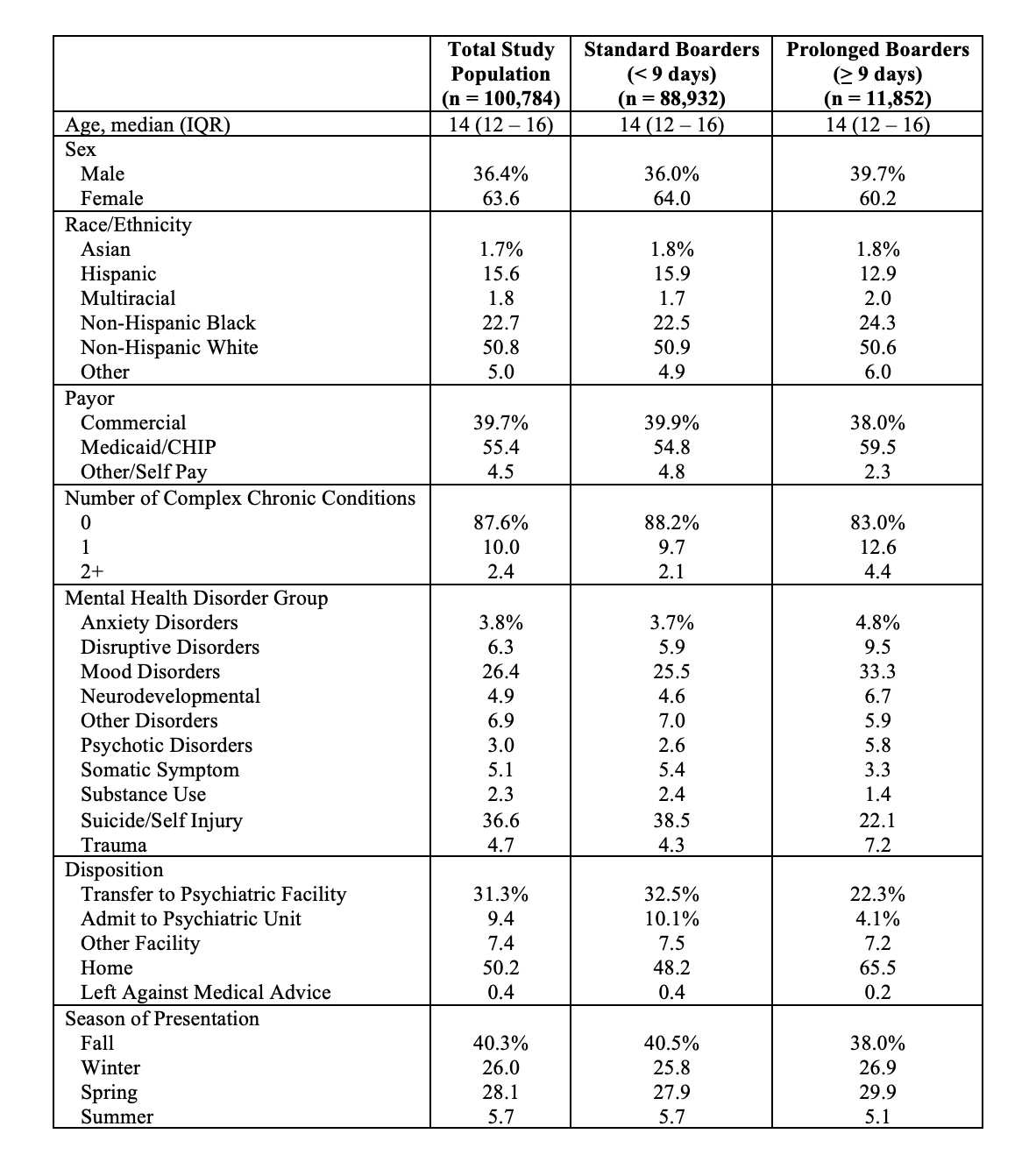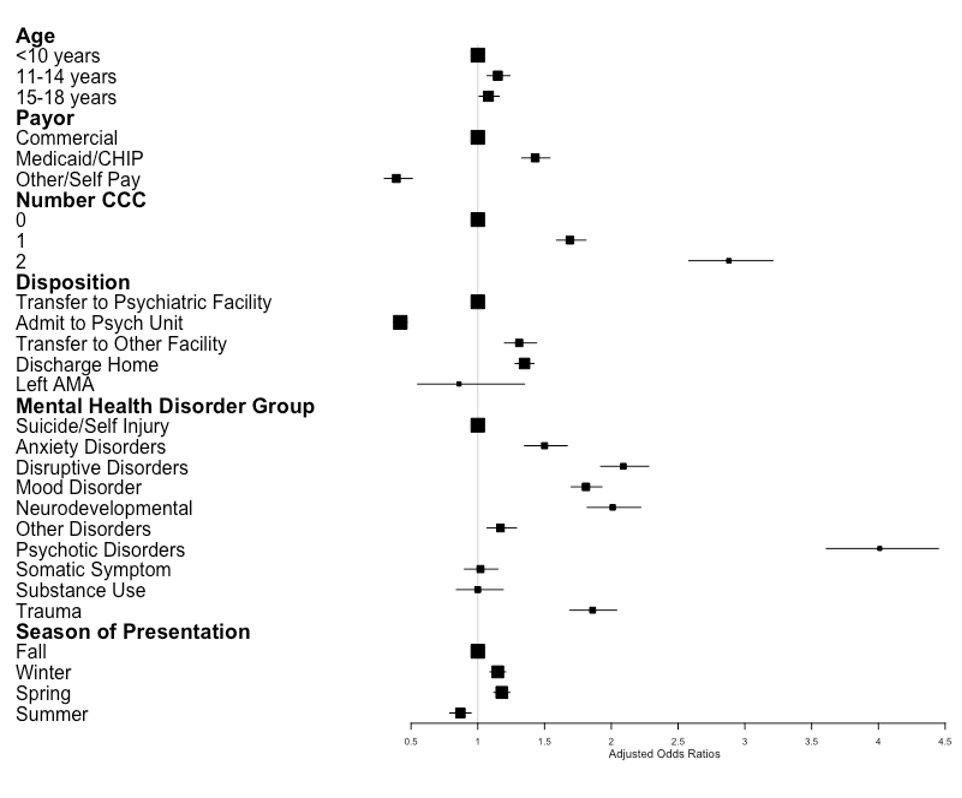Mental Health 4
Session: Mental Health 4
102 - Pediatric Mental Health Boarding: Trends at US Children’s Hospitals 2017-2023
Monday, April 28, 2025
7:00am - 9:15am HST
Publication Number: 102.6144
Kathleen D. Snow, Boston Children's Hospital, Boston, MA, United States; Jonathan Mansbach, Boston Children's Hospital, Boston, MA, United States; Christopher A. Cortina, Boston Children's Hospital, Boston, MA, United States; Jay Berry, Complex Care, Boston Children's Hospital, Boston, MA, United States; Amanda S. Growdon, Boston Children's Hospital, Boston, MA, United States; Patricia A. Stoeck, Boston Children’s Hospital/Harvard Medical School, Boston, MA, United States; Kathleen E. Walsh, Boston Children's Hospital, Boston, MA, United States

Kathleen D. Snow, MD, MPH (she/her/hers)
Instructor in Pediatrics
Boston Children's Hospital
Boston, Massachusetts, United States
Presenting Author(s)
Background: Pediatric mental health (MH) conditions are increasing, exacerbated by the stressors of the COVID-19 pandemic, but national shortages of community behavioral health resources and inpatient psychiatric beds persist. As a result, patients experiencing acute psychiatric crisis often board in emergency departments or inpatient medical units while awaiting placement, delaying access to necessary care.
Objective: To describe pre- and post-COVID trends in pediatric MH boarding encounters at US children’s hospitals and to identify factors associated with prolonged boarding.
Design/Methods: We performed a retrospective cross-sectional study analyzing pediatric MH boarding encounters at 40 tertiary children’s hospitals included in the Pediatric Health Information System (PHIS) database between January 1, 2017 and December 31, 2023. Children ages 3-18 presenting with a primary psychiatric diagnosis were included in the analysis. We assessed trends in boarding encounters and length of stay over time. Risk factors for prolonged boarding (>9 days) were identified using mixed effects logistic regression models.
Results: Between 2017 and 2023, there were 100,784 boarding encounters across 40 hospitals. Boarding encounters peaked in 2021 (20,647) and have remained above pre-pandemic levels through 2023 (Table 1). Median length of stay increased from 3 to 4 days (p < 0.001) across the study period and 350 (0.3%) children had stays of longer than 100 days. Among children who experienced boarding, median age was 14 years (IQR 12-16), 63.6% were female, 50.8% were non-Hispanic white (Table 2). Most patients (87.6%) did not have any underlying complex chronic conditions. The most common presenting MH diagnoses included suicide/self-injury (36.6%) and mood disorders (26.4%). Factors associated with prolonged boarding included older age, government insurance type, increasing medical complexity, neurodevelopmental, disruptive or psychiatric disorders, winter or spring presentation, and discharge home or to a non-psychiatric facility (Figure 1). Patients admitted to an inpatient psychiatric unit within the children’s hospital had a significantly decreased odds of prolonged boarding (aOR 0.42, 95% CI 0.37 – 0.47).
Conclusion(s): Boarding while awaiting acute psychiatric care remains common, with a sustained increase in volume of boarding encounters and length of stay since the onset of the COVID-19 pandemic. Patients with medical and/or psychiatric complexity may be more likely to experience prolonged boarding, highlighting an area for improved access to care.
Trends in pediatric mental health encounters and boarding encounters, 2017-2023
 Boarding encounters were defined as pediatric mental health encounters with a length of stay of two or more calendar days in the ED and/or inpatient medical unit.
Boarding encounters were defined as pediatric mental health encounters with a length of stay of two or more calendar days in the ED and/or inpatient medical unit. Characteristics of pediatric mental health boarding encounters, 2017-2023
 All results presented above as percentage of encounters meeting criteria for each category. Prolonged boarders defined as those with a length of stay in the top 90th percentile of all study encounters.
All results presented above as percentage of encounters meeting criteria for each category. Prolonged boarders defined as those with a length of stay in the top 90th percentile of all study encounters.CCC: Complex Chronic Conditions; CHIP: Children’s Health Insurance Program
Patient and hospitalization factors associated with prolonged boarding length of stay
 Forest plot demonstrates adjusted odds ratios and 95% confidence intervals for covariates found to be significantly associated with prolonged length of stay for boarding encounters in mixed effects logistic regression model. Other non-significant variables included in the model were sex and race/ethnicity.
Forest plot demonstrates adjusted odds ratios and 95% confidence intervals for covariates found to be significantly associated with prolonged length of stay for boarding encounters in mixed effects logistic regression model. Other non-significant variables included in the model were sex and race/ethnicity. Trends in pediatric mental health encounters and boarding encounters, 2017-2023
 Boarding encounters were defined as pediatric mental health encounters with a length of stay of two or more calendar days in the ED and/or inpatient medical unit.
Boarding encounters were defined as pediatric mental health encounters with a length of stay of two or more calendar days in the ED and/or inpatient medical unit. Characteristics of pediatric mental health boarding encounters, 2017-2023
 All results presented above as percentage of encounters meeting criteria for each category. Prolonged boarders defined as those with a length of stay in the top 90th percentile of all study encounters.
All results presented above as percentage of encounters meeting criteria for each category. Prolonged boarders defined as those with a length of stay in the top 90th percentile of all study encounters.CCC: Complex Chronic Conditions; CHIP: Children’s Health Insurance Program
Patient and hospitalization factors associated with prolonged boarding length of stay
 Forest plot demonstrates adjusted odds ratios and 95% confidence intervals for covariates found to be significantly associated with prolonged length of stay for boarding encounters in mixed effects logistic regression model. Other non-significant variables included in the model were sex and race/ethnicity.
Forest plot demonstrates adjusted odds ratios and 95% confidence intervals for covariates found to be significantly associated with prolonged length of stay for boarding encounters in mixed effects logistic regression model. Other non-significant variables included in the model were sex and race/ethnicity. 
